[ad_1]
AirPods can work surprisingly well as hearing aids. Thanks to Transparency mode, AirPods Pro will boost the sound of your environment around you. They can give you freaky Spiderman super-hearing if you boost input volume to the max. And Conversation Boost on the latest AirPods Pro 2 can intelligently raise the volume of people talking to you (while lowering the volume of your music or podcasts).
My prescription hearing aids were out of action recently due to a battery problem, so for a few weeks, I used my AirPods Pro as hearing aids.
For the most part, they’ve been pretty good. They work best when set up properly, which is a bit of a chore, but here’s how to do it.
This post contains affiliate links. Cult of Mac may earn a commission when you use our links to buy items.
How to use AirPods as hearing aids
If you experience mild to moderate hearing loss, you can use AirPods Pro as great part-time hearing aids, boosting sound in noisy environments. They also work well as a substitute when you forget your regular hearing aids (or their batteries run out of charge).
Apple’s noise-canceling earbuds also can serve as a great starter device. Most prescription hearing aids cost between $3,000 and $10,000, and require professional hearing tests, fitting and adjustment. Before diving in, you might want to experiment with boosting your hearing with a pair of AirPods Pro.
There’s also no social stigma against wearing AirPods as there is with wearing hearing aids. No one will know you’re using them to augment your hearing — although you might appear rude at first keeping them in while you talk.
They can give you superhuman hearing capable of picking up whispered conversations across the room, too. Just boost the input volume to the maximum. Note: Be very careful listening to anything at high volumes; even just a few minutes at a loud volume can damage your ears even further.
AirPods Pro (2nd generation) with USB-C charging case
The latest model AirPods Pro 2 are among the best wireless earbuds you can buy for your iPhone and other Apple gear. They offer excellent sound quality, battery life and active noise cancellation, among other advanced features.
We earn a commission if you make a purchase, at no additional cost to you.
03/13/2024 02:09 pm GMT
Researchers say AirPods are already as good as hearing aids
Professional hearing aids are super-expensive, but researchers found that AirPods already work nearly as well as most hearing aids. In 2020, scientists pitted a pair of AirPods 2 and first-gen AirPods Pro against a basic hearing aid and a premium pair. In almost all the tests, they found the AirPods Pro were as good as the basic hearing aid and only slightly less effective than the premium pair. Even the AirPods 2 “helped participants hear more clearly compared with wearing no hearing aids,” the study found.
Apple doesn’t yet have approval from the Food and Drug Administration to sell AirPods as OTC hearing aids and hasn’t made any announcements about this possibility, but it’s rumored to come soon. The company has been adding a lot of features to AirPods Pro that make them suitable — including Conversation Boost, muting background sounds, and particularly Transparency Mode, which makes all this possible.
AirPods Pro work great as part-time or starter hearing aids, but they’re not a full-time replacement yet.
Apple’s earbuds still don’t work as well as my Oticon More hearing aids: The battery life is much shorter (AirPods Pro get about five to six hours versus 18 to 24 hours for the Oticons), and they aren’t as good at boosting voices.
I’ve been using Apple’s latest AirPods Pro (second generation), which Apple launched in September 2022, as substitute hearing aids.
You may not know you need hearing aids
Most people don’t know they are suffering from hearing loss. Studies show that only 20% of people with hearing problems wear a hearing aid.
I was in this boat myself. I had trouble hearing people speak in loud environments, but I had no idea of the extent of my deafness until I got fitted with hearing aids. When I first tried them on, I was astounded and almost choked up. Suddenly, I could hear the leaves rustling in the trees and sand crunching underfoot as people passed by: sounds I was oblivious to beforehand. It’s been an amazing experience getting my hearing back.
If you own AirPods Pro, perhaps you should try setting them up as hearing aids to see if they make any difference. If so, you can then explore getting prescription hearing devices.
Start with an audiogram
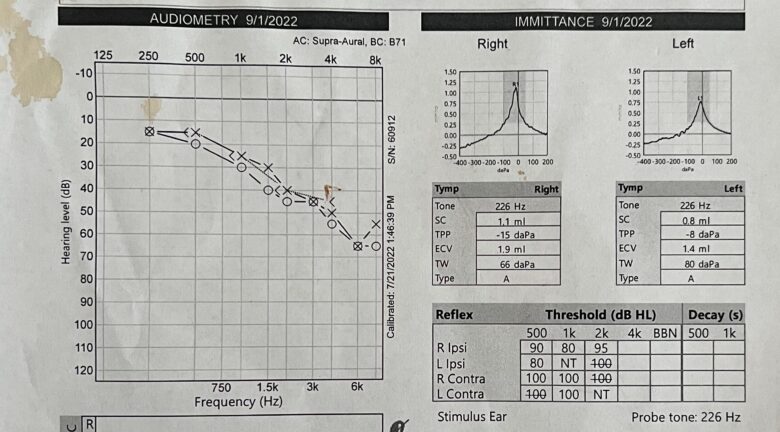
Before setting up AirPods as hearing aids, I highly recommend getting an audiogram, a chart that shows the results of a hearing test. It shows how loud sounds need to be for you to hear them at different frequencies — low-pitched through high-pitched. As you can see in the audiogram above, I have moderate hearing loss in higher frequencies: The test tones had to be played at much higher decibels in order for me to hear them.
If you import an audiogram, your AirPods will create an individualized sound profile for you, boosting the frequencies you have trouble hearing. It makes a huge difference.
If you’ve taken a professional hearing test, you’ll likely have been given an audiogram — usually, it’s just a printout. Simply take a picture of your audiogram with your iPhone and it’ll be ready to import.
Luckily, you don’t have to take a professional hearing test: Some free apps will create very accurate audiograms for you. (Jump to the section below detailing how to get a free audiogram using an app.)
However, you don’t need an audiogram to use AirPods as hearing aids. There’s a built-in hearing test during the setup process that gets pretty close.
AirPods as hearing aids: Step-by-step setup instructions
Here are the steps to transform AirPods into assistive hearing devices.
7. After taking the test, choose Custom Settings.
8. If you have an audiogram already saved, choose it when customizing Headphone audio.
Here’s what the whole process looks like with screenshots:
1. Open Settings on your iPhone or iPad, then Accessibility, then AirPods
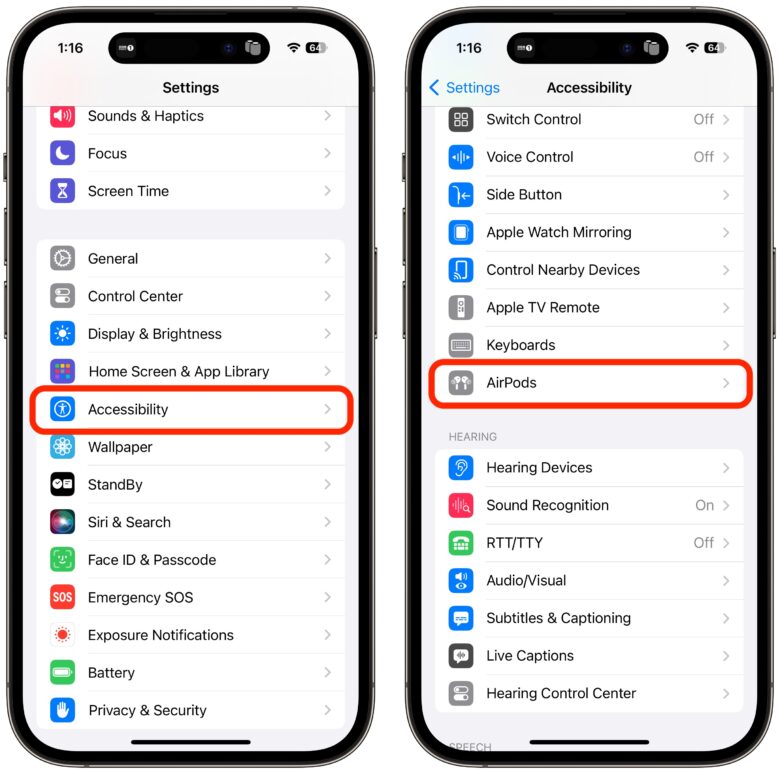
Screenshot: Leander Kahney/Cult of Mac
First, connect your AirPods to your iPhone. (This works the same way on an iPad.) Then open the Settings app on your iPhone, then tap Accessibility. Scroll down to AirPods and tap that to select the AirPods you want to customize.
2. Scroll down to Audio Accessibility Settings
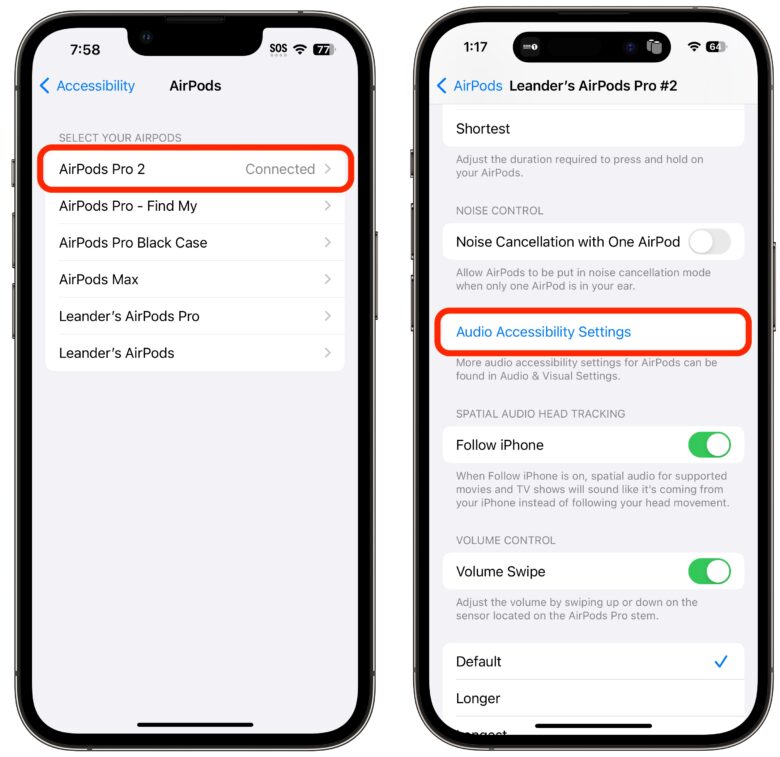
Screenshot: Leander Kahney/Cult of Mac
Make sure you are wearing your AirPods, then tap on them if your device says they are Connected. On the next screen, scroll down to Audio Accessibility Settings.
3. Tap Headphone Accommodations, then Custom Audio Setup
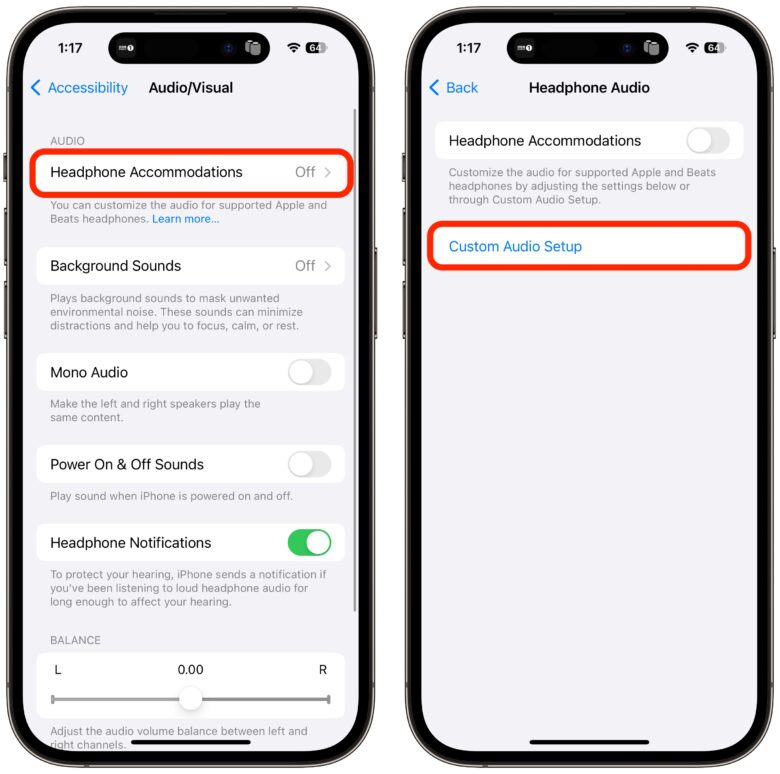
Screenshot: Leander Kahney/Cult of Mac
At the top of the screen, tap Headphone Accommodations, then tap Custom Audio Setup. The next screen asks you to add your audiogram.
4. Import your audiogram
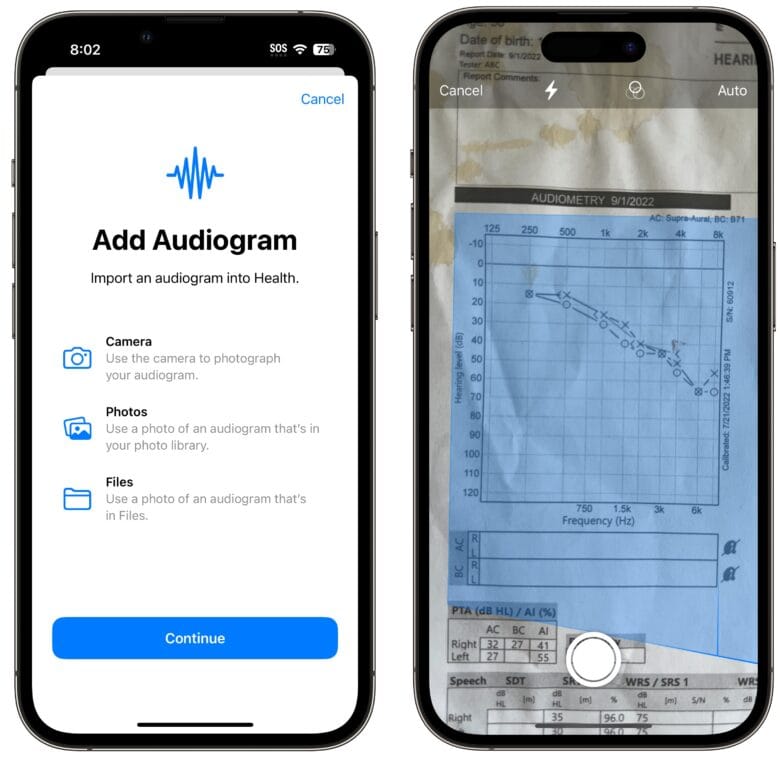
Screenshot: Leander Kahney/Cult of Mac
If you have an audiogram printout, hit Continue in the setup wizard. If doing this for the first time, you’ll first be asked to add your audiogram. Choose Add Audiogram, then import the chart using the iPhone’s Camera, Photos or Files app. I used my iPhone’s camera to take a picture of the audiogram I got from a professional hearing test, and the camera imported the results automatically.
After importing, if there’s any data missing, you’ll be asked to fill in any missing numbers.
5. Customize your AirPods Pro’s Transparency Mode
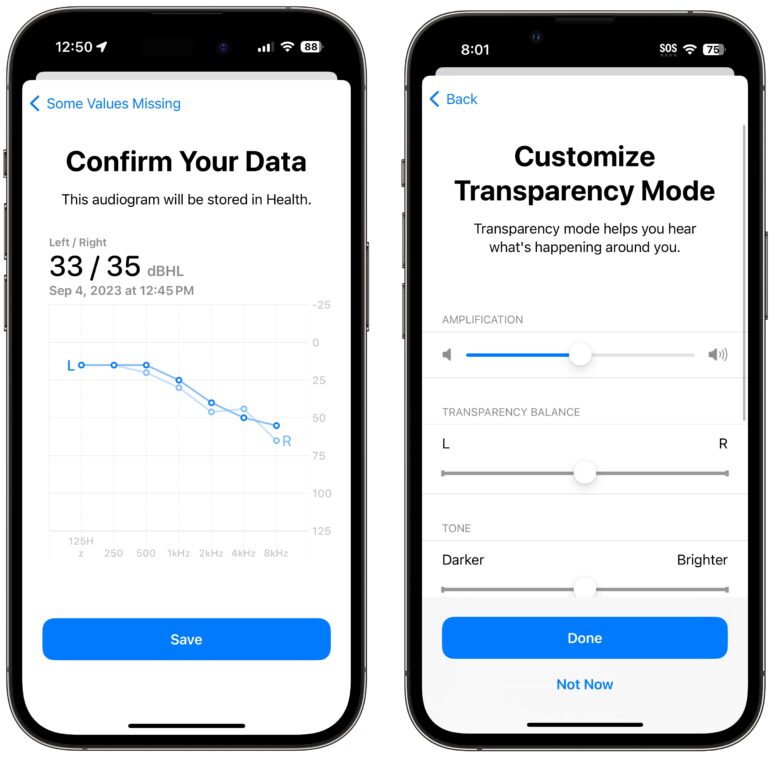
Screenshot: Leander Kahney/Cult of Mac
After hitting Save, you can adjust amplification (basically the volume level of the AirPods you’ll be using as hearing aids), left and right balance, and tone. You can turn on Ambient Noise Reduction and Conversation Boost, both of which should make it easier to hear people in face-to-face conversations. I recommend turning on both of these, and went with the default amplification. (I crank it up for Spiderman-like super-hearing as needed.)
Hit Done.
6. If you don’t have an audiogram, take the built-in hearing test (or use a free app)
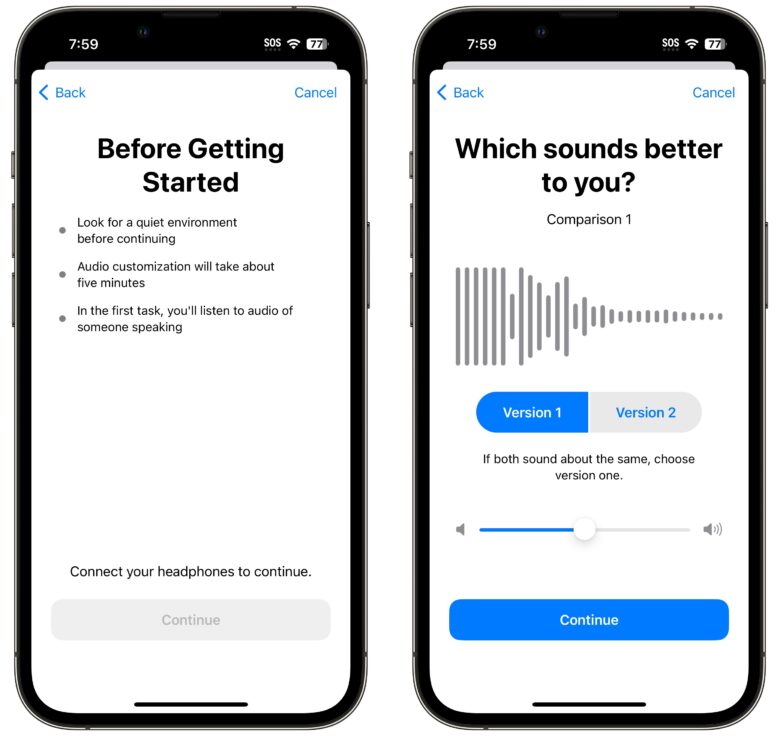
Screenshot: Leander Kahney/Cult of Mac
If you don’t have an audiogram, you can take Apple’s built-in hearing test to generate one. First, make sure you’re in a quiet environment. The test asks you to compare samples of music and voices, asking which sounds better — version 1 or version 2. If they sound about the same, choose the first one. The test takes just a couple of minutes.
Alternatively, you can use one of the free apps mentioned below to generate an audiogram.
7. After taking the hearing test, make sure to choose Custom Settings
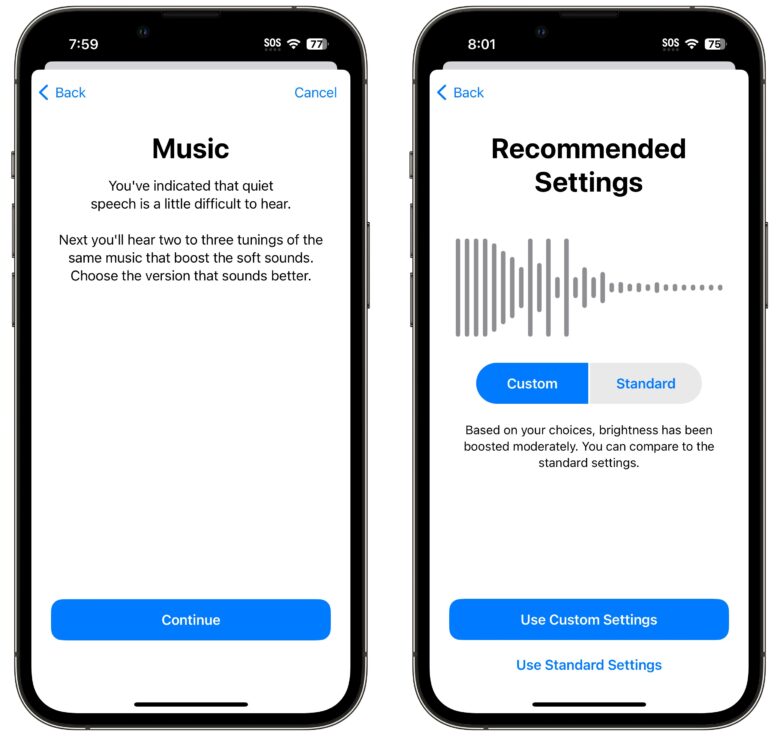
Screenshot: Leander Kahney/Cult of Mac
At the end of the built-in hearing test, make sure to choose Custom Settings.
8. If you have an audiogram already saved, choose it when customizing Headphone audio
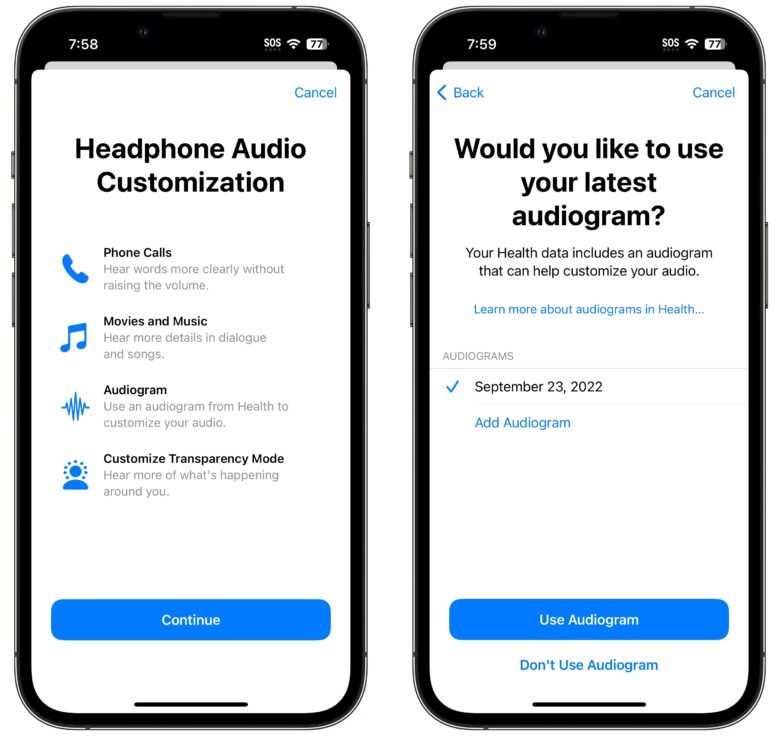
Screenshot: Leander Kahney/Cult of Mac
You may already have an audiogram saved in the Health app. If so, it’ll appear on the first screen after hitting Custom Audio setup in step 3 above.
Choose the latest audiogram, and hit Use Audiogram. You’ll then be able to customize settings, as in Step 6 above.
How to get an audiogram using a free app
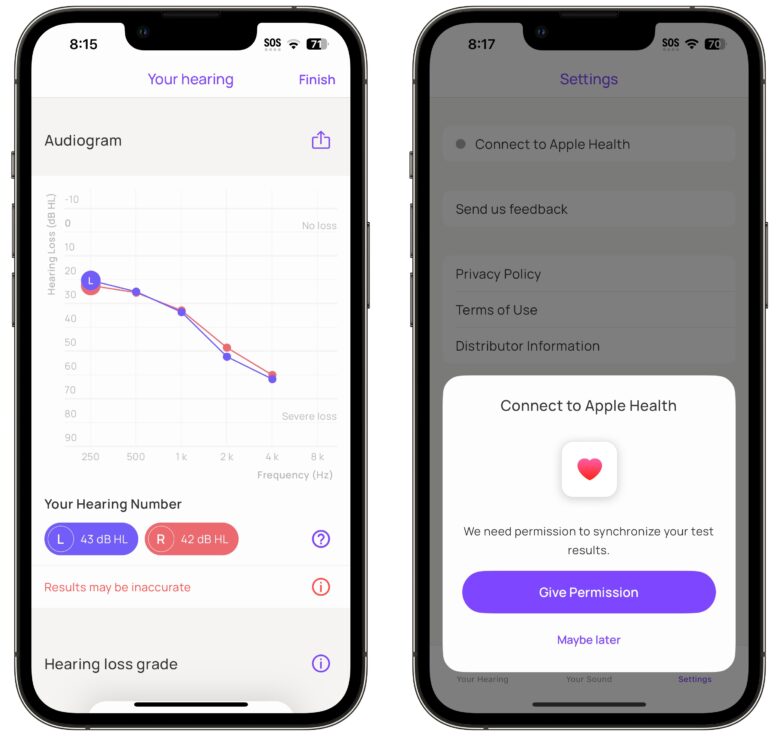
Screenshot: Leander Kahney/Cult of Mac
If you don’t have an audiogram, you can use the Mimi Hearing Test or SonicCloud Personalized Sound apps. After taking the free hearing test, simply import the results into the Health app.
Both these apps mimic a professional hearing test. You listen to a range of tones at various frequencies and volumes, and the app creates an audiogram based on your responses.
I tried both apps and got basically the same results as the professional audiogram, which makes me confident they are both pretty accurate. However, the numbers from both apps were slightly off. (That could indicate my hearing deteriorated since my last professional hearing test.)
Obviously, if you want the greatest accuracy, head to your doctor or hearing specialist.
After taking the hearing test in either app, you’ll be asked to connect to Apple Health. Since this is private health information, you must permit the third-party apps to connect with the Health app. Hit Give Permission.
Your audiogram will be imported and will show up in the custom audio process.
Which AirPods offer Transparency Mode?
Using AirPods as hearing aids relies on Transparency Mode, which lets in outside sounds so you can hear what’s happening around you. Transparency Mode is often used when listening to music, but if you use your AirPods in Transparency Mode without any media playing, they act as hearing aids.
Transparency Mode is available on the following AirPods and Beats earbuds:
- AirPods Pro (first and second generation)
- AirPods Max
- Beats Studio Buds
- Beats Studio Buds +
- Beats Fit Pro
AirPods Pro (2nd generation) with USB-C charging case
The latest model AirPods Pro 2 are among the best wireless earbuds you can buy for your iPhone and other Apple gear. They offer excellent sound quality, battery life and active noise cancellation, among other advanced features.
We earn a commission if you make a purchase, at no additional cost to you.
03/13/2024 02:09 pm GMT
More posts about AirPods and hearing health
[ad_2]
Source Article Link


